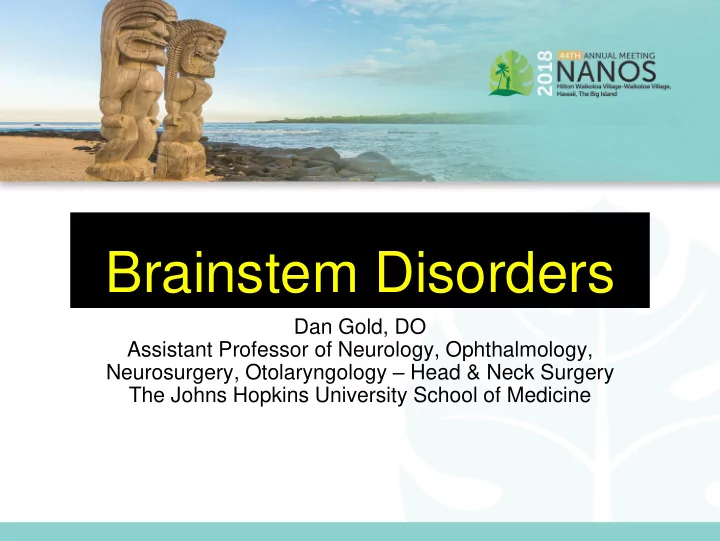

Brainstem Disorders Dan Gold, DO Assistant Professor of Neurology, Ophthalmology, Neurosurgery, Otolaryngology – Head & Neck Surgery The Johns Hopkins University School of Medicine
Relevant Financial Disclosures • I have no financial interests or relationships to disclose.
Outline • 1) Lateral Medullary Syndrome • Saccadic dysmetria • Nystagmus • Semicircular canal & utricle imbalance • 2) Medial Longitudinal Fasciculus Syndrome • Nystagmus • Semicircular canal & utricle imbalance • 3) Oculopalatal Tremor
1) Lateral Medullary (Wallenberg) Syndrome
Lateral Medullary Syndrome SACCADIC DYSMETRIA & OCULAR LATEROPULSION
Is the lateral medullary lesion on the right or the left? RIGHT
Is the lateral medullary lesion on the right or the left? LEFT
R L Left lateral medullary lesion
R L Disruption of climbing fibers (ICP)
R L Increased Purkinje firing increased fastigial inhibition Simple spike (inhibitory) discharge of Purkinje cells increases
R L Inhibition of fastigial nucleus… …Decreased excitation of contra IBN
R L Decreased inhibition of left VIth N & PPRF results in overaction of these structures, bias towards the left
R L PEARL: End result with L Wallenberg is L hypermetria & L ocular lateropulsion
Lateral Medullary Syndrome NYSTAGMUS
Unidirectional Nystagmus
Is this right 8 th nerve or right lateral medullary?
Central SCC imbalance Peripheral SCC imbalance Semicircular canals (SCC) – angular acceleration detectors
Result is mixed left- Unopposed L PC beating mixed + L HC + L AC horizontal-torsional nystagmus
PEARL: At the level of the labyrinth/8 th N & medulla, nystagmus can be UNIDIRECTIONAL & indistinguishable
Torsional Nystagmus
Is this right 8 th nerve or right lateral medullary?
Can you have pure torsional nystagmus from a peripheral lesion? PEARL: Pure TORSIONAL nystagmus is almost always central
Gaze-Evoked Nystagmus
Wernicke’s encephalopathy PEARL: MVN-NPH responsible for horizontal gaze-holding GAZE-EVOKED NYSTAGMUS
Lateral Medullary Syndrome VESTIBULO-OCULAR REFLEX
Is this vestibular neuritis or lateral medullary? Abnormal Head Impulse Test (HIT) to the RIGHT
RIGHT Vestibular neuritis Damage to horizontal SCC fibers in 8 th nerve
Is this vestibular neuritis or lateral medullary? Abnormal Head Impulse Test (HIT) to the LEFT
LEFT Wallenberg Damage to horizontal SCC fibers synapsing in the MVN
PEARL: While an abnormal (+) HIT is almost always indicative of a peripheral etiology, certain central localizations (vestibular nucleus) can cause this finding
Lateral Medullary Syndrome UTRICULAR-OCULAR REFLEX
Utricle – linear acceleration detector, responds to translation & head tilt
1) Head tilts right 2) Right eye elevates & Left eye depresses 3) Ocular counter-roll towards left ear Physiologic Ocular Tilt Reaction (OTR)
Skew Deviation Pathologic OTR from Wallenberg on LEFT (PEARL: caudal to decussation of utricle-ocular motor fibers, ipsi- hypotropia)
PEARL: Although a “peripheral” skew is possible, it is rare and usually small. Presence of a skew should be considered central until proven otherwise.
2) Medial Longitudinal Fasciculus (MLF) Syndrome
Left INO due to left MLF injury What we won’t talk about
MLF Syndrome NYSTAGMUS
Why? MLF lesions – PEARL: Torsional nystagmus is ipsiversive & vertical components can be dissociated
Most common patterns • Ipsiversive torsional component &… • 1) UBN OU, more in the contralateral eye • 2) DBN OU, more in the ipsilateral eye • 3) Jerky (or hemi-) seesaw nystagmus with dissociated vertical components • UBN in the contralateral eye • DBN in the ipsilateral eye
How can the ipsiversive torsional nystagmus be explained? Semicircular Canal Pathways
L R L R Slow (contraversive) torsional phase towards right ear & Fast (ipsiversive) torsional phase toward left ear PEARL: Left MLF injury damages PC & AC pathways originating in Right Labyrinth
PEARL: Ipsiversive torsional nystagmus can be generated by vertical (posterior & anterior) SCC asymmetry
Skew deviation with Left hypertropia (PEARL: rostral to decussation of utricle-ocular motor fibers, ipsi-hypertropia)
What produces dissociated vertical components? 1) Semicircular Canal Pathways
Stimulate R PC (BPPV) activate R SO, L IR Slow phase down/towards left ear Fast phase up/towards right ear
Weaker L IR Stronger L SR upward slow phase more DB OS (ipsilesional to MLF) Torsional towards left ear; more DB OS
Weaker R SR Stronger R IR downward slow phase more UB OD (contralesional to MLF) Torsional towards left ear; more UB OD
What produces dissociated vertical components? 2) Utricle-ocular motor Pathways
Skew (OD) – slow phase Skew (OS) – slow phase down; fast phase up up; fast phase down Left MLF lesion causes Left hypertropia & Right hypotropia PEARL: Fast phases UB OD, DB OS “Jerky see -saw ”
MLF Syndrome VESTIBULO-OCULAR REFLEX
3 pathways for 1 pathway for anterior SCC posterior SCC
PEARL: PC VOR more affected than AC VOR with MLF lesions
May experience oscillopsia from vertical SCC weakness
MS patient with bilateral MLF lesions PEARL: Abnormal HIT (VOR) in the planes of the posterior canals Normal HIT (VOR) in the planes of the anterior canals
3) Oculopalatal Tremor (OPT)
Central tegmental tract
CTT injury IO hypertrophy & CTT normally spontaneous inhibits IO discharges Guillain- Mollaret’s triangle
Take Home Points • 1) Lateral Medullary Syndrome • Ipsilesional hypermetria and ocular lateropulsion • Ipsilesional hypotropia • Can have an abnormal VOR • Can have unidirectional nystagmus indistinguishable from “peripheral” nystagmus • Or, gaze-evoked nystagmus, torsional nystagmus
Take Home Points • 2) MLF Syndrome • Ipsilesional hypertropia • Dissociated torsional (ipsiversive)-vertical nystagmus • Most common is more UB in contralesional eye • VOR abnormality in the planes of the posterior canals
Take Home Points • 3) OPT • Guillain Mollaret’s triangle • Commonly seen with horizontal gaze palsies, related to central tegmental tract pathology • Don’t forget to look at the palate when pendular nystagmus is present!
Recommend
More recommend